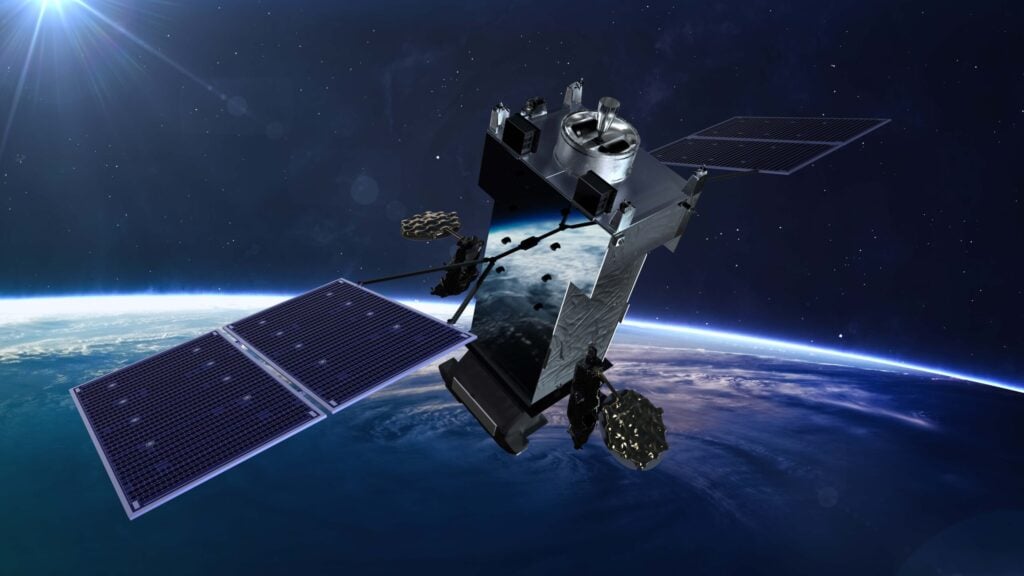
Lockheed Martin’s Next Generation Overhead Persistent Infrared Geosynchronous Earth Orbit (NGG) Block 0 early missile warning satellite. (Lockheed Martin)
AFA 2022 — The Space Force is still going through with the first iteration of its multi-billion Next Generation Overhead Persistent Infrared System (Next-Gen OPIR) missile warning/tracking satellite program. But once those systems are launched, they’ll represent the last of their kind, with the service instead focusing on constellations in lower orbits, Space Development Agency Director Derek Tournear said today.
“The path that the Space Force is marching towards is that we won’t rely on those in the future,” he told reporters at the annual Air and Space Forces Association conference near Washington, DC. “We’ll do away with the GEOs, and the big, exquisite expensive satellites.”
The Next-Gen OPIR program is a series of three geosynchronous orbit (GEO) sats being built by Lockheed Martin, and two satellites in highly elliptical polar orbits, being built by Northrop Grumman. The Pentagon at the moment plans to launch the first Next-Gen OPIR GEO satellite (called NGG, for “Next Generation Geosynchronous”) in 2025 or 2026, and to have the entire constellation on orbit by 2029.
The first three NGG sats originally were designated Block 0 by SSC, and the plan had been that they would be replaced in the future by more capable blocks — in a manner similar to the SBIRS program before it. Now, that is not the case — meaning that Lockheed’s decades-long lock on missile warning/missile tracking from GEO will also be coming to an end.
The Space Force asked for a whopping sum of nearly $3.5 billion for the Next-Gen OPIR program in its fiscal 2023 Research, Development, Test and Evaluation (RTD&E) budget request, covering development of advanced technologies, the two types of satellites in different orbits, ground systems, and integration. Between FY23 and FY27, the service is budgeting nigh on $12 billion for the program.
Tournear explained that the NGG satellites will remain as part of the missile warning/tracking architecture through their lifetimes, which usually stretches to at least 15 years. But after that, he said, missile warning/tracking will take place from low Earth orbit and medium Earth orbit, rather than rely on large expensive ones in GEO. And while that timeline — roughly 2045 or so — may seem far off, by the standards of space programs, such decisions need to happen now.
Instead, in the future, the US military will rely on the large constellation of a couple hundred LEO missile warning/tracking satellites being developed by SDA, and the network of at least four satellites in Medium Earth Orbit (MEO) now being planned under “Resilient Missile Warning Missile Tracking – Medium Earth Orbit (MEO),” by the Space Force’s Space Systems Command.
“We will have this proliferated layer in LEO and MEO that provides missile warning, missile tracking, and then also what we call the fire control from the LEO layer,” Tournear said. “So, you’ll get missile warning missile tracking and full missile defense from LEO, and then missile warning/missile tracking from the Next-Gen OPIR development program is being developed to replace the current Space Based Infrared System (SBIRS) satellites.”
Satellites in LEO and MEO are not only more capable of tracking hypersonic missiles, but also provide more resilience through sheer numbers — complicating the targeting calculus of adversaries such as Russian and China.
The plan to ditch missile warning from GEO stems from the force design study completed late last year by the Space Force’s Space Warfighting Analysis Center.
The decision to go ahead with a MEO development program was signed off by the Space Acquisition Council on Jan. 27, and also was based on the SWAC’s force design — which focused not only on the traditional mission of detecting the launch of ballistic missiles and tracking their trajectory, but also on highly maneuverable hypersonic missiles that are a challenge for current systems.
The idea is that the ground system for the new MEO constellation will be integrated with the LEO satellite constellation optimized for hypersonic missile tracking that SDA is developing in partnership with the Missile Defense Agency under what the Space Force now calls the “Resilient Missile Warning/Missile Tracking – Low Earth Orbit (LEO)” program.
The first eight of those LEO sats are part of SDA’s “Tranche 0,” which also includes 20 “Transport Layer” data relay satellites. They will be launched by the end of the year, after a 3 month slip in schedule caused by supply chain issues. SDA in October 2020 awarded SpaceX $149 million and L3Harris $194 million to each build four Tracking Layer Tranche 0 satellites, designed to detect ballistic, cruise and hypersonic missiles using a wide field of view IR sensor.
L3Harris and Northrop Grumman beat out five other contractors for development of SDA’s second set of satellites, called Tranche 1 Tracking Layer. Each contractor will build 14 satellites under an Other Transaction Authorities (OTA) contract: L3 Harris’s award with a potential value of approximately $700 million; and Northrop Grumman’s potentially worth about $617 million, according to SDA’s press release. SDA plans to begin launching the satellites in 2025.






















